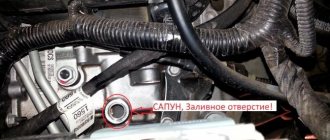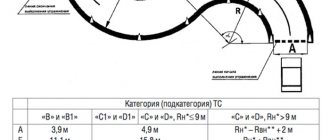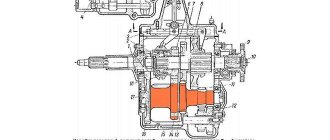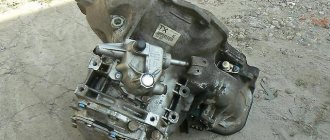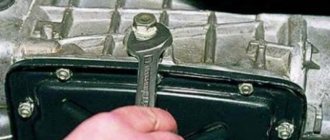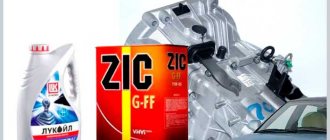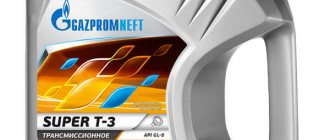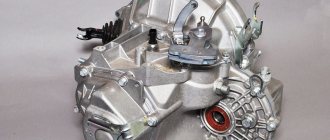A car is a complex unit consisting of many components, elements and parts. One of these components is a manual transmission, the correct operation of which requires not only compliance with operating rules, but also timely and high-quality maintenance.
Maintenance of a manual transmission consists of checking the oil level in the box, partial or complete oil change, flushing the manual transmission (if necessary), timely repairs, adjustments, etc. Next, we will look at when and why you need to flush the manual transmission before changing the oil.
The need to flush the manual transmission: how to flush the box, when and why
Let's start with the fact that usually a complete oil change in the box is carried out approximately every 60-70 thousand kilometers (the oil can be changed either independently or at a station). Also, before changing the oil, if necessary, the manual transmission is washed.
Maintenance of any car includes a number of routine maintenance, including checking the oil in the box. The quality and level of oil in the manual transmission must comply with the technical standards of the manufacturer. In practice, there are often cases when an oil change is carried out a little earlier than the scheduled maintenance.
- inability or difficulty shifting gears;
- shifting gears, accompanied by extraneous sounds (grinding, noise, etc.);
- discrepancy between the selected gear and the speed limit of the vehicle, etc.
Flushing the manual transmission when changing the oil helps:
- softening and removal of various deposits, wear products, etc.;
- cleaning oil channels, improving the circulation of oil fluid;
- complete removal of old oil;
- extending the service life of oil seals and rubber seals.
What is manual transmission flushing oil?
Traditional flushing oil, both for internal combustion engines and gearboxes, is an inexpensive mineral oil with the addition of detergents and various additives that prevent wear of gearbox elements. As a rule, zinc and phosphorus are used as additives, and calcium as detergents.
The flushing liquid (oil) not only washes away the remnants of old used oil, but also neutralizes the acidic environment formed since the last oil change.
If the contamination is serious enough, the box is disassembled to eliminate it (each individual element is mechanically cleaned and washed).
How to flush the automatic transmission yourself
So, it is recommended to completely flush the automatic transmission in cases where the ATP fluid was heavily contaminated, the oil in the box has not been changed for a long time, for preventive purposes, etc. At the same time, washing the automatic transmission with your own hands is a completely affordable procedure and can easily be done in a garage. Note that there are several available flushing methods, which are usually combined with changing the oil in the automatic transmission.
The first method is that the oil is first drained from the box, then the automatic transmission filter is replaced, then the box is washed, the oil is drained again, after which a clean filter is installed, and a new portion of fluid is filled strictly according to the level.
To accomplish this task, you will need to have 12-15 liters of ATF or Dexron fluid. Wherein . After the old oil has been drained, the oil filter has been replaced and the automatic transmission pan has been replaced, fresh oil is poured into the box.
Then a flushing device is connected to the automatic transmission cooling system (the pipes of the device are connected to the system in the places where the automatic transmission radiator is connected). After this, the engine is started, then the unit runs for 10-20 minutes.
After the engine, you can turn off the engine, wait a while for the oil to drain into the sump, remove the sump again, drain the oil, and replace the automatic transmission filter again. At the end, the automatic transmission drain plug gasket, pan gasket is replaced, or sealant is applied.
The device remains connected to the cooling system. Next, you need to start the engine again and allow the previously filled oil to pass through the system for several circles. During flushing, you also need to turn on different automatic transmission modes so that the oil spreads through different channels and lines, cleaning all automatic transmission parts.
Once the liquid pumped out of the device becomes completely clean, and the amount of oil being poured is equal to the amount that flows out, the process can be considered complete. This method of flushing and changing the oil in an automatic transmission is usually called full-flow.
Now let's consider a simpler method, since flushing the automatic transmission in this case is not difficult. In fact, the procedure is partly similar to engine flushing, when special flushing agents are used that are poured directly into the exhaust. In simple words, flushing is added to the old oil. The only thing, as in the first case, is that you need to have a flushing device at your disposal, which is connected to the pipes of the automatic transmission cooling system.
In a nutshell, the box warms up, flushing is poured into the heated old oil, then the device is connected. After this, you need to start the engine, the automatic transmission selector is set to position P “parking” or “neutral” N. While the engine is running, the oil circulates through the system, cleaning occurs.
After the oil with additives has cleaned the unit, the flushing can be considered complete
Then the waste is drained, and it is important to remove as much oil as possible from the unit. Now all that remains is to fill in fresh oil according to the level
As you can see, this is a simpler method, since you do not need to fill and drain the fluid twice (first remove waste, then flush) and change the automatic transmission filters before and after flushing.
We also note that in some cases a special automatic transmission flushing oil containing special additives is also used. This solution is poured into the automatic transmission after draining the waste, then, at the end of the cleaning process, the flushing needs to be drained and fresh oil refilled, after first replacing the automatic transmission filter.
Flushing an automatic transmission with diesel fuel, gasoline or kerosene is also an affordable method. At the same time, it is not recommended to use such a solution in practice unless there is an urgent need, since some automatic transmissions may turn out to be extremely sensitive to what is poured into the unit, that is, they may fail or begin to work incorrectly.
If we talk about the flushing itself, the whole point is that some of the oil is drained from the box, kerosene is added, then the engine starts and runs for 15-20 minutes. After this, the engine is turned off, some more oil is drained, and kerosene is refilled. However, the engine does not start further; the mixture of oil and kerosene remains in the box for 1-2 hours.
At the end, the mixture of ATP and kerosene is drained in as much as possible, then washed with regular oil. Next, this oil also needs to be drained, after which the automatic transmission filter is changed and fresh transmission fluid is added.
Flushing the gearbox on all VAZ cars
Welcome! Flushing the box - many people already know that it is necessary to flush the engine after any defective oil, because if it is not washed, then the defective oil (a fake, one might say) will remain on the walls of the engine and will gradually begin to destroy it, but Few people know that the situation is exactly the same with the gearbox, so when filling in fake oil or if you mixed any oils (This cannot be done, only as a last resort), flushing the gearbox is mandatory and must be done.
Note! To flush, you will only need to buy: Firstly, the flushing oil itself for the box, as well as a special syringe with which you will pour oil into the box (If there is no syringe, then in this case you can make a special thing from improvised means, thanks to which it will also be possible to pour oil into the box, we will tell you how to do this a little lower in the article which you will follow the link) and you will also need to stock up on wrenches and spanners, and in addition, buy a wide container that will hold 5 liters !
Where is the gearbox? On all front-wheel drive cars that are produced by VAZ, the gearbox is located in the same place, namely it is installed at the end of the car’s engine, so if we take into account the fact that the engine is located transversely and not longitudinally as on the classics, then accordingly and the box will be located on the side and at the very bottom, so that you can better understand its location, then in this case, look just below the photo in which it is indicated by an arrow under the number 3.
Note! Now, as for the classics, for many people the location of the gearbox on classic cars does not cause any difficulties at all and people immediately point their finger at it, but not all people unfortunately know this, so for these people we explain that the gearbox is located on classic cars immediately under the gear shift lever, which is located in the cabin (you can navigate by it), so that you can clearly understand its location, see the photo below, it is indicated by an arrow on it!
When should you wash the box? As mentioned earlier, due to low-quality burnt oil, it is necessary to flush the box, because it can lead to the formation of corrosion, which in turn can have a very serious impact on the box; in addition, washing must be done if you mixed oils of two different brands and with different additives ( In this case, a very unpleasant mixture of additives occurs, which will also damage the gearbox), and you also need to do washing if, after you drained the used oil from the unit, it turned black and metal shavings were found in it, these shavings fly from the gears of the gears, they can fly due to improper operation of the box (sharp engagement and gear shifting at high speeds) or due to the fact that there was practically no oil in the unit when you operated the car, in this case, thanks to flushing all the remaining parts of the oil with metal shavings on the walls of the box will merge into a container and after that you can fill in normal oil, and you can be sure that these chips have been removed from the unit.
How to flush the gearbox on all VAZ cars?
Note! We would like to immediately note that the flushing instructions are tailored for front-wheel drive cars; in principle, everything is the same with rear-wheel drive cars, they just have the box in a slightly different place and pouring flushing oil into it will be much more convenient than on front-wheel drive!
1) Flushing is done as follows, firstly, if you have a front-wheel drive car, then study the article on changing the oil in it, this article is called: “Changing the oil in the box on a VAZ 2110” (Do not pay special attention to the make of the car, since the box that on the Priora, that on 2114, that on the Grant and that on other cars it was installed very similar to each other), but if you have a rear-wheel drive car, then everything is a little different here, about how to change the oil in it, read the article: “ Changing the oil in a box on a VAZ”, these articles describe everything in detail.
Oil selection parameters
There are a number of criteria that must be taken into account in order to choose an oil with the optimal viscosity for your gasoline or diesel engine.
It is important to use products that are labeled to meet the vehicle manufacturer’s approvals.
We choose only labeled motor oil
It is not recommended to experiment and fill your engine with the first option you come across. Otherwise, this may negatively affect its operation and lead to the most unfavorable consequences, including major repairs.
Viscosity
This parameter is key when selecting engine oil for any vehicle and period of operation. However, not everyone understands what this term means. In simple terms, this is the ability of fuels and lubricants to maintain their properties at a certain temperature. We are talking about the following parameters:
- lubrication of rubbing elements;
- reducing friction force;
- reducing fuel consumption.
It is very important that all these properties are perfectly preserved not only at positive temperatures, but also at negative temperatures. Viscosity parameters are indicated by all manufacturers on the label
The SAE system is used for this.
Classification of motor oils according to SAE. For example, the packaging indicates a combination of synthetics 5w30 or 5w40. The number “5” indicates the viscosity of the oil at negative temperatures, and the second number at positive values.
It is important to know that this is an index, not a temperature indicator.
If you are wondering what viscosity oil is best for winter with very low temperatures, you should give preference to a lubricant that has a synthetic base.
API classification of oils - table
Turnability and pumpability
These are two more important criteria that are directly dependent on viscosity
You should also pay attention to them when faced with the choice of oil for use in winter. If you don’t know which oil to fill in in winter: synthetic or semi-synthetic, keep in mind that the first option allows the engine to start easier
The best choice of oils in the box is synthetics
Such a product has sufficient fluidity; it is pumped faster through the oil channels, minimizing the negative consequences of a cold start at low temperatures.
If you fill in synthetic oil in winter, you can see that the engine will start easier. This is due to the fact that a liquid with such a consistency will not create much resistance to the crankshaft, and will allow it to start easily even in severe frost.
If you don’t know what type of oil to fill in during the cold season, you should read the owner’s manual to understand what recommendations the manufacturer gives. This will allow you to understand how to choose the right consumables for your car so that it does not fail even in extreme operating conditions.
Instructions for using engine oil in the winter season
Is it possible to use mineral oil?
The composition of such fuels and lubricants includes ingredients of natural and artificial origin. If the list of components contains only petroleum products, this product has a mineral base.
Due to the high content of components isolated from fuel oil, soot and soot appear on the internal elements. This negatively affects the life of the engine and its performance characteristics. In cold weather, such a product will easily thicken and therefore it is not recommended to use it in winter.
Coked engine from using mineral oil
The mineral water should be changed after 5–7 thousand kilometers. If the vehicle is operated in active mode, the oil life expires much faster.
All-season
The multi-grade engine oil that has appeared on the market is the best option only if the car is operated in regions with a temperate climate.
Operating principle of flushing oils
Table for assessing the degree of contamination of engine parts.
Before changing the gearbox oil, let the engine run for a while. The heated grease will drain faster and better. After draining the old fluid, fill in the flushing fluid in exactly the same volume as the working fluid. Let the engine idle again. In about 20 minutes, the washing liquid should have time to rinse the entire box. The used flushing oil must be drained and replaced with working oil.
Do I need to use a flush? Flushes are practically not used abroad, so you won’t see flushes from Castrol or Shell on store shelves. Such manufacturers claim that if all maintenance standards are observed, there is no work to be done for flushing. But this statement is true subject to a number of conditions:
- The car must be new, from the showroom.
- The quality of the fuel must be impeccable.
- The oil is changed frequently and the transmission is serviced regularly.
These conditions are not always feasible for our country. Cars are not always purchased from a dealership, and recommended regulations are almost never followed. It is for such cases that flushing comes in handy.
Innovation in the market. Quite recently, a new product appeared on domestic shelves - LAVR. This tool opens up completely new perspectives in car maintenance. Usually no one really thinks about why the checkpoint is not usually cleaned of contamination?
Benefits of LAUREL oil.
Gearboxes and axles are also often left without proper attention. If you think about it, these components bear no less load than an engine in which the oil is changed regularly.
The reason lies in the fact that car manufacturers consider these components to be maintenance-free. LAVR became the first domestic product for cleaning gearboxes, drive axles and transfer mechanisms of both cars and trucks. This product is indicated for use at every oil change in these units. The manufacturer guarantees the following results:
- Absence of wear products during operation in gearboxes and other components.
- Increased service life of units where flushing is used.
- Restoring the plasticity of rubber seals.
- The use of reducing and antifriction additives significantly enhances the effect of using LAVR.
How to use LAVR
How to wash the transmission with your own hands? This is easy to do if you use LAUREL.
- The flushing liquid is poured into the used motor oil through the oil filler neck (one hundred milliliters of product per liter of oil product).
- By means of an overpass or jacks, the front wheels of the car are raised above the ground.
- The engine starts, transmission modes change randomly for ten minutes.
- Upon completion of washing, the used oil product and the washing agent are drained, and fresh motor oil is poured in.
Transmission maintenance is not included in the car service regulations. If the car was purchased secondhand, there is no guarantee that all necessary procedures were carried out on time and correctly. Any service center will tell you that gearbox lubricant changes its color and consistency during operation. This is due to oxidation and accumulation of wear products. These changes affect the functioning of the transmission.
Do I need to flush the gearbox when changing the oil?
| “When changing the oil in the gearbox, do I need to flush it? If yes, then with what?” Alexey Rogozin There is no need to flush the gearbox (gearbox) when changing its oil. The fact is that the operating mode of transmission oil is much softer than engine oil. In the gearbox, the “transmission” does not heat up to high temperatures, no fuel gets into it and there is no contact with exhaust gases, as a result of which the oil practically does not oxidize and tar deposits do not form on the parts. Existing solid particles - products of mechanical wear of parts - accumulate in the lower part of the crankcase, so when draining the old oil they are easily removed. It should be remembered that the oil should only be drained when it is warm, when its viscosity is minimal. This is best done in warm weather, after a trip. The less viscous heated oil is removed by gravity better, while simultaneously washing away almost all impurities from the bottom of the crankcase. |
|
Types of flushes
The procedure for cleaning the engine when changing the oil directly depends on the type of flushing fluid used:
Special flushing oil
This is a technical fluid with a mineral composition, which includes many active additives. Unlike the “five-minute”, it does not wash off the protective layer from the rubbing parts, having a milder effect on the internal combustion engine. But you also need to use it no longer than 5-10 minutes, at idle speed
Manufacturers recommend using it before adding new oil. You need to drive the flushing oil in a gentle mode (as during break-in - low load, speed no higher than 3000 per minute) for 100-200 km, and then fill in new oil and change the filter.
Regular motor oil
A technical fluid with reduced quality or viscosity is used. You can flush the engine with the same oil that is planned to replace the previous fluid. To do this, the engine must be operated for 1-2 days and the lubricant must be replaced again.
Chemical compositions of the “five-minute”
These are organic solvents that resemble ordinary water in consistency. To clean the engine, such liquid must be poured into the engine, instead of old oil, and let it run for 5-10 minutes in idle mode. Then the oil is changed to a new one, with the oil filter replaced.
It is strictly forbidden to operate the engine for five minutes, as there is a chance of heating the rubbing surfaces, followed by a wedge of the piston group.
The compositions have an aggressive composition; when mixed with old oil, unwanted chemical reactions can occur. The problem is aggravated by incomplete removal of the composition when adding new oil.
Diesel fuel and kerosene
Flushing with diesel fuel, kerosene in diluted form (add 50% by volume of oil), or without dilution. This is an old method, it has its fans, it captivates with its cheapness.
However, it is strictly not recommended to flush the engine when changing the oil (and in any case) using such means. Fuel can damage the seals. Intensive washing out of deposits can negatively affect the engine lubrication system, clogging its small-diameter channels with lumps of deposits.
The lubricating properties of diesel fuel and kerosene are insufficient; during operation, intensive wear of engine friction pairs occurs.
Also, when changing the oil, you must also change the oil filter. Otherwise, there is a chance that the new technical fluid will react with sediment and lose its beneficial properties.
conclusions
Engine flushes should not be used without compelling reasons.
If flushing is carried out, change the oil again after 2-3 thousand km without using flushing compounds.
The best flushing is a timely change of engine oil. By reducing the interval between oil changes to 7.5 thousand km, you can increase the service life of the engine. Old deposits will be slowly washed away without harming it.
Change the oil after pre-warming the engine. Drain through a special hole at the bottom of the engine crankcase. Take your time and let the remaining old oil drain.
Algorithm of actions
Flushing the hydraulic unit should be carried out sequentially, which will not only ensure high quality work, but also simplify its implementation independently. Dismantling and washing the automatic transmission varies somewhat depending on the specific car model. The washing algorithm includes the following steps:
Initially, the car owner needs to dismantle the hydraulic unit, for which the oil is drained from the box, the electrical connector plugs and pan are removed using star keys, and the unit itself is unscrewed. After opening the oil sump, you need to pay attention to the presence of metal shavings on the catching magnet. If there is too much of it, this indicates wear on the moving shafts of the box
The automatic transmission may soon require major repairs. Using a star wrench, the bolts that secure the front and rear lobes are unscrewed. You should loosen and unscrew the fasteners that clamp the hydraulic unit board. The intermediate plate is carefully lifted, after which all existing bolts and fasteners are unscrewed from it. After this, you can carefully remove the valve body from the car, which is then cleaned of dirt using carb cleaner, diesel fuel and a rag. To clean the valve body, you need to disassemble all the parts. Use a brush with hard bristles to brush away all dry dirt. The internal channels are washed with carb cleaner. You should use protective gloves and goggles, as the product causes irritation and burns if it comes into contact with the skin. After cleaning the valve body, wash the valves with gasoline and wipe all parts with a dry, clean rag. Assembly and installation of the block is carried out in the reverse order. It is necessary to use a torque wrench, which is used to tighten the four fastening bolts with a force of 11 N/m. After installing the valve body, you need to clean the oil pan from the old sealant, apply a thin layer of new sealant along the contour, install the pan and fill in with fresh transmission oil. You should start the car and let the engine idle for several minutes. The automatic transmission selector lever switches in turn with a delay of approximately 30 seconds to all positions that process the oil. Only after this can you begin to move. In the future, operating the automatic transmission will not cause any trouble.
When servicing a car, many owners wash the automatic transmission filter to save money, then install it back and clean the valve body. However, most service workshop specialists recommend replacing the filter element to eliminate future difficulties when operating the car.
Cleaning the automatic transmission valve body restores the functionality of the box and eliminates problems in the operation of the automatic transmission. The procedure is not particularly difficult, and car owners who have even a basic understanding of car repair and maintenance will be able to perform it themselves, saving on visiting service centers.
Procedure for using LAUR
- The flush is poured directly into the old oil
through the filler hole in the amount of 100 ml of flush per 1 liter of oil. - Using a lift or jacks, the driving wheels of the car are suspended in the air.
- The engine starts, then you need to switch gears in random order within 10 minutes.
- After completing this procedure, the old oil
oil
should be poured in its place .
Read
Purpose. This innovative product works on a completely new principle.
Gearbox diagram
.
During operation, the automatic transmission produces a certain amount of output, some of which settles on the oil filter, and the other remains in the cavities of the mechanism’s numerous channels. Over time, there is more and more dirt in the automatic transmission, which seriously disrupts its operation. Often, simply replacing the transmission fluid and box filter is not enough to improve the operation of the unit. In such a situation, you will have to resort to flushing the automatic transmission. For those motorists who do not know about the procedure for carrying out this procedure, our resource has prepared the material presented today. Fortunately, washing the automatic transmission is quite doable with your own hands in a more or less equipped garage.
Causes of manual transmission contamination
The most common reason for contamination and the need to flush the gearbox is water getting into the mechanism. The manual transmission is leaking. It must be in contact with the atmosphere to avoid the formation of excess pressure or vacuum due to temperature changes.
The valve, which provides air inflow or outflow (breather), is located at the top of the box. Under normal operating conditions, it works normally, but if the car gets into a deep puddle, water enters the breather. The box cools sharply, and the transmission oil turns into an emulsion. If such a liquid is not replaced in time, the process of hydrolysis begins, that is, “saponification” of the oil. At the same time, it loses all its lubricating and cleaning properties.
Transmission fluid can also cause contamination of the manual transmission if it overheats for a long time. This occurs when driving for a long time at high speed or in off-road conditions, or when towing a heavy load. Due to unacceptably high temperatures, the oil in the box begins to “cook”, forming something like an ointment.
Deposits in the manual transmission oil pan, as well as on other parts of the unit, are caused by oxidized oil if oil change intervals are not observed.
